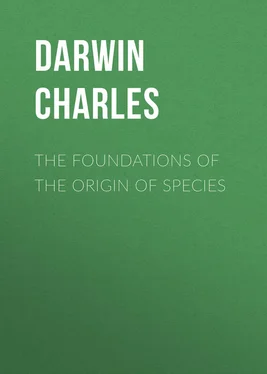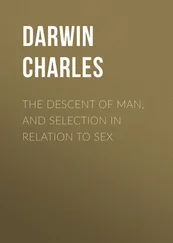Charles Darwin - The Foundations of the Origin of Species
Здесь есть возможность читать онлайн «Charles Darwin - The Foundations of the Origin of Species» — ознакомительный отрывок электронной книги совершенно бесплатно, а после прочтения отрывка купить полную версию. В некоторых случаях можно слушать аудио, скачать через торрент в формате fb2 и присутствует краткое содержание. Жанр: foreign_antique, foreign_prose, на английском языке. Описание произведения, (предисловие) а так же отзывы посетителей доступны на портале библиотеки ЛибКат.
- Название:The Foundations of the Origin of Species
- Автор:
- Жанр:
- Год:неизвестен
- ISBN:нет данных
- Рейтинг книги:3 / 5. Голосов: 1
-
Избранное:Добавить в избранное
- Отзывы:
-
Ваша оценка:
- 60
- 1
- 2
- 3
- 4
- 5
The Foundations of the Origin of Species: краткое содержание, описание и аннотация
Предлагаем к чтению аннотацию, описание, краткое содержание или предисловие (зависит от того, что написал сам автор книги «The Foundations of the Origin of Species»). Если вы не нашли необходимую информацию о книге — напишите в комментариях, мы постараемся отыскать её.
The Foundations of the Origin of Species — читать онлайн ознакомительный отрывок
Ниже представлен текст книги, разбитый по страницам. Система сохранения места последней прочитанной страницы, позволяет с удобством читать онлайн бесплатно книгу «The Foundations of the Origin of Species», без необходимости каждый раз заново искать на чём Вы остановились. Поставьте закладку, и сможете в любой момент перейти на страницу, на которой закончили чтение.
Интервал:
Закладка:
Give sketch of the Past, – beginning with facts appearing hostile under present knowledge, – then proceed to geograph. distribution, – order of appearance, – affinities, – morphology &c., &c.
Our theory requires a very gradual introduction of new forms 107 107 See Origin , Ed. i. p. 312, vi. p. 453.
, and extermination of the old (to which we shall revert). The extermination of old may sometimes be rapid, but never the introduction. In the groups descended from common parent, our theory requires a perfect gradation not differing more than breed«s» of cattle, or potatoes, or cabbages in forms. I do not mean that a graduated series of animals must have existed, intermediate between horse, mouse, tapir 108 108 See Origin , Ed. i. pp. 280, 281, vi. p. 414. The author uses his experience of pigeons for examples for what he means by intermediate ; the instance of the horse and tapir also occurs.
, elephant [or fowl and peacock], but that these must have had a common parent, and between horse and this «?» parent &c., &c., but the common parent may possibly have differed more from either than the two do now from each other. Now what evidence of this is there? So perfect gradation in some departments, that some naturalists have thought that in some large divisions, if all existing forms were collected, a near approach to perfect gradation would be made. But such a notion is preposterous with respect to all, but evidently so with mammals. Other naturalists have thought this would be so if all the specimens entombed in the strata were collected 109 109 The absence of intermediate forms between living organisms (and also as regards fossils) is discussed in the Origin , Ed. i. pp. 279, 280, vi. p. 413. In the above discussion there is no evidence that the author felt this difficulty so strongly as it is expressed in the Origin , Ed. i. p. 299, – as perhaps “the most obvious and gravest objection that can be urged against my theory.” But in a rough summary written on the back of the penultimate page of the MS. he refers to the geological evidence: – “Evidence, as far as it does go, is favourable, exceedingly incomplete, – greatest difficulty on this theory. I am convinced not insuperable.” Buckland’s remarks are given in the Origin , Ed. i. p. 329, vi. p. 471.
. I conceive there is no probability whatever of this; nevertheless it is certain all the numerous fossil forms fall in«to», as Buckland remarks, not present classes, families and genera, they fall between them: so is it with new discoveries of existing forms. Most ancient fossils, that is most separated «by» space of time, are most apt to fall between the classes – (but organisms from those countries most separated by space also fall between the classes « e. g. » Ornithorhyncus?). As far as geological discoveries «go» they tend towards such gradation 110 110 That the evidence of geology, as far as it goes, is favourable to the theory of descent is claimed in the Origin , Ed. i. pp. 343-345, vi. pp. 490-492. For the reference to net in the following sentence, see Note 1, p. 48, {Link: Note 161} of this Essay.
. Illustrate it with net. Toxodon, – tibia and fibula, – dog and otter, – but so utterly improbable is «it», in ex. gr. Pachydermata, to compose series as perfect as cattle, that if, as many geologists seem to infer, each separate formation presents even an approach to a consecutive history, my theory must be given up. Even if it were consecutive, it would only collect series of one district in our present state of knowledge; but what probability is there that any one formation during the immense period which has elapsed during each period will generally present a consecutive history. [Compare number living at one period to fossils preserved – look at enormous periods of time.]
Referring only to marine animals, which are obviously most likely to be preserved, they must live where «?» sediment (of a kind favourable for preservation, not sand and pebble) 111 111 See Origin , Ed. i. p. 288, vi. p. 422. “The remains that do become embedded, if in sand and gravel, will, when the beds are upraised, generally be dissolved by the percolation of rain-water.”
is depositing quickly and over large area and must be thickly capped, «illegible» littoral deposits: for otherwise denudation «will destroy them», – they must live in a shallow space which sediment will tend to fill up, – as movement is «in?» progress if soon brought «?» up «?» subject to denudation, – [if] as during subsidence favourable, accords with facts of European deposits 112 112 The position of the following is not clear: – “Think of immense differences in nature of European deposits, – without interposing new causes, – think of time required by present slow changes, to cause, on very same area, such diverse deposits, iron-sand, chalk, sand, coral, clay!”
, but subsidence apt to destroy agents which produce sediment 113 113 The paragraph which ends here is difficult to interpret. In spite of obscurity it is easy to recognize the general resemblance to the discussion on the importance of subsidence given in the Origin , Ed. i. pp. 290 et seq., vi. pp. 422 et seq.
.
I believe safely inferred «that» groups of marine «?» fossils only preserved for future ages where sediment goes on long «and» continuous«ly» and with rapid but not too rapid deposition in «an» area of subsidence. In how few places in any one region like Europe will «?» these contingencies be going on? Hence «?» in past ages mere [gaps] pages preserved 114 114 See Note 3, p. 27.
. Lyell's doctrine carried to extreme, – we shall understand difficulty if it be asked: – what chance of series of gradation between cattle by «illegible» at age «illegible» as far back as Miocene 115 115 Compare Origin , Ed. i. p. 298, vi. p. 437. “We shall, perhaps, best perceive the improbability of our being enabled to connect species by numerous, fine, intermediate, fossil links, by asking ourselves whether, for instance, geologists at some future period will be able to prove that our different breeds of cattle, sheep, horses, and dogs have descended from a single stock or from several aboriginal stocks.”
? We know then cattle existed. Compare number of living, – immense duration of each period, – fewness of fossils.
This only refers to consecutiveness of history of organisms of each formation.
The foregoing argument will show firstly, that formations are distinct merely from want of fossils «of intermediate beds», and secondly, that each formation is full of gaps, has been advanced to account for fewness of preserved organisms compared to what have lived on the world. The very same argument explains why in older formations the organisms appear to come on and disappear suddenly, – but in [later] tertiary not quite suddenly 116 116 The sudden appearance of groups of allied species in the lowest known fossiliferous strata is discussed in the Origin , Ed. i. p. 306, vi. p. 446. The gradual appearance in the later strata occurs in the Origin , Ed. i. p. 312, vi. p. 453.
, in later tertiary gradually, – becoming rare and disappearing, – some have disappeared within man’s time. It is obvious that our theory requires gradual and nearly uniform introduction, possibly more sudden extermination, – subsidence of continent of Australia &c., &c.
Our theory requires that the first form which existed of each of the great divisions would present points intermediate between existing ones, but immensely different. Most geologists believe Silurian 117 117 Compare Origin , Ed. i. p. 307, vi. p. 448.
fossils are those which first existed in the whole world, not those which have chanced to be the oldest not destroyed, – or the first which existed in profoundly deep seas in progress of conversion from sea to land: if they are first they «? we» give up. Not so Hutton or Lyell: if first reptile 118 118 I have interpreted as Sandstone a scrawl which I first read as Sea ; I have done so at the suggestion of Professor Judd, who points out that “footprints in the red sandstone were known at that time, and geologists were not then particular to distinguish between Amphibians and Reptiles.”
of Red Sandstone «?» really was first which existed: if Pachyderm 119 119 This refers to Cuvier's discovery of Palæotherium &c. at Montmartre.
of Paris was first which existed: fish of Devonian: dragon fly of Lias: for we cannot suppose them the progenitors: they agree too closely with existing divisions. But geologists consider Europe as «?» a passage from sea to island «?» to continent (except Wealden, see Lyell). These animals therefore, I consider then mere introduction «?» from continents long since submerged.
Интервал:
Закладка:
Похожие книги на «The Foundations of the Origin of Species»
Представляем Вашему вниманию похожие книги на «The Foundations of the Origin of Species» списком для выбора. Мы отобрали схожую по названию и смыслу литературу в надежде предоставить читателям больше вариантов отыскать новые, интересные, ещё непрочитанные произведения.
Обсуждение, отзывы о книге «The Foundations of the Origin of Species» и просто собственные мнения читателей. Оставьте ваши комментарии, напишите, что Вы думаете о произведении, его смысле или главных героях. Укажите что конкретно понравилось, а что нет, и почему Вы так считаете.












